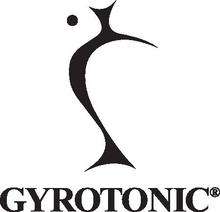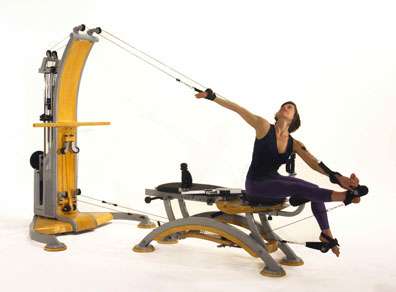Gyrotonic
 | |
| Industry | Physical fitness |
|---|---|
| Founder | Juliu Horvath |
| Headquarters | Corporate Headquarters- Dingman's Ferry, Pennsylvania, USA |
Area served | Asia, Australasia, Middle East, North America, South America |
Key people |
Juliu Horvath, Founder, President, CEO Matthew Aversa, Vice President, COO |
| Products | exercise equipment, accessories, dvds |
| Services | Teacher Training Courses in the Gyrotonic and Gyrokinesis Method |
| Parent | Gyrotonic Sales Corp |
| Website |
www |
The Gyrotonic Expansion System is composed of the Gyrokinesis and Gyrotonic exercise methods. The Gyrokinesis Method, originally called “Yoga for Dancers,” is practiced on a mat & chair, and the Gyrotonic Method uses specialized equipment that permits one to move with support and resistance. Gyrotonic and Gyrokinesis exercise sequences are intended to increase the functional capacity of the entire organism in a harmonious way. Both methods embrace key principles also found in swimming, dance, yoga, tai chi, and gymnastics, and emphasize continuous, flowing movements, synchronized with corresponding breath patterns.[1]
Gyrotonic and Gyrokinesis exercise sequences are usually taught in a one-hour private or group class at a Gyrotonic studio, or fitness facility.[2]
History
Gyrotonic Expansion System creator, Juliu Horvath, an ethnic Hungarian born in Timisoara, Romania in 1942, developed the Gyrotonic Expansion System after his personal struggle with chronic pain and injury. Horvath was a swimmer and gymnast before becoming a ballet dancer with the Romanian State Opera (currently known as the Timisoara Romanian National Opera) in his early 20’s.[3] He defected from Romania in 1970 while touring with the Romanian State Opera in Italy. After spending 6 months in a refugee camp in Italy, Horvath was granted asylum in the United States, subsequently dancing professionally with the New York City Opera and the Houston Ballet.[1]
Horvath tore his Achilles tendon, and herniated a vertebral disc while dancing with the Houston Ballet, injuries that ended his dance career.[1] After these injuries, he moved back to New York City for a short time, where he began a regular yoga practice. Horvath moved to the island of St. Thomas in the Virgin Islands in 1977. There he built a small, one-room hut in the mountains and, in an effort to rehabilitate his injuries, devoted the next six years to intensive yoga and meditation practices.[4] During this period of intense self-study, Horvath began to develop what was once called “Yoga for Dancers” and has since evolved into the Gyrokinesis Method.[5]
When Horvath left St. Thomas, he returned to New York City where he began to teach Yoga for Dancers at Steps on Broadway. He established the first Gyrotonic studio-White Cloud Studio, in 1984.[1] In the beginning, most of Horvath's students were professional dancers. As demand for his classes grew, and the diversity of his clientele increased, he refined Yoga for Dancers, creating a class format that almost any person could perform, regardless of age or state of health. He named this refined version of Yoga for Dancers, the Gyrokinesis Method.[4]
At White Cloud Studio, Horvath continued to develop and refine the method he created in St. Thomas. It was here where he began to develop the Gyrotonic Method, and made the first pieces of Gyrotonic equipment. As of 2013, Horvath continues to create new programming for the Gyrotonic and Gyrokinesis Methods. He also conducts teacher training courses internationally, continues to develop new Gyrotonic equipment, and continues to refine existing equipment designs. In 2013, the Gyrotonic Expansion System encompassed over 2500 Gyrotonic studios, with 7800 Gyrotonic, and Gyrokinesis Trainers practicing in 52 countries.[4]
Principles
Four primary principles of the Gyrotonic Expansion System are listed below.[6]
Intention
"Intention is the driving force that moves the body."(Juliu Horvath)[6] It is a person's vision that guides his/her movement in the desired direction.
Stabilization through Contrast
"Instead of attempting to create stabilization by fixing or holding the body in a particular position, The Gyrotonic Expansion System encourages the mover to find a balance between reaching, or lengthening outward (extending or expanding), and pulling inward toward the bodies core (tensing, or retracting). This opposition is not static, instead there is a continuous wave like pulsation of reaching out, and reeling in from the center of the body. In this way stability is attained by a counterbalance of opposing forces." (Joyce Campbell)
Decompression of the joints
Joints that are overly compressed cannot move freely. Decompression of the joints can be attained by utilizing the principle of stabilization through contrast, along with cuing exercisers to articulate joints with a scooping, curvilinear motion. By creating a scooping motion, and moving around joints in a circular manner, greater space may be attained in the joints, optimizing the quality,and efficiency of most joint movements.
Coordination of movement and breath
The Gyrotonic Expansion System stresses the value of using a corresponding breath pattern for each movement. Generally this involves inhaling when a movement is intended to expand, or open, and exhaling when a movement is intended to contract, or close.
Benefits
Some of the benefits that may be gained by practicing the Gyrotonic,and Gyrokinesis methods are increased circulation; cardiovascular stimulation; increased mobility of the joints; stimulation, and strengthening of the nervous system; mobilization of the spine; improved sense perception; greater balance, and flow of energy; and improved coordination.[1]
Gyrotonic equipment
The Gyrotonic Method utilizes specially designed exercise equipment. All Gyrotonic equipment is developed by Gyrotonic Expansion System Creator, Juliu Horvath.[7] Horvath designed Gyrotonic equipment to accommodate the natural movement patterns of the human body. Gyrotonic equipment incorporates curvilinear wooden framework, and has numerous adjustments so that it can be customized to each users unique physique, and physical ability.[8]
There are five different models of Gyrotonic equipment used commercially by Gyrotonic trainers. The Pulley Tower Combination Unit is the most widely used piece of Gyrotonic Equipment.[9] The other four models of equipment are categorized as Specialized Equipment. Gyrotonic Specialized Equipment includes: the Jumping Stretching Board, the Gyrotoner, the Leg Extension Unit, the Archway.[10]

Juliu Horvath quotes
The following are quotes by Juliu Horvath regarding Gyrotonic Expansion System movement qualities:[1]
“The octopus, the monkey and the cat are my basic models because they can move in any direction at any given time with strength and control because they have no restrictions. The human body has restrictions, but I can model the body ─ within the framework of its restrictions ─ to move in a similar way, to be free,”
“I want music in my body and poetry in my body, and I want to be skillful without struggle; it has to come without struggle.”
“I discovered Kundalini energy through my pain and agony, and somehow that awakened me. Being awakened energetically means that you can read the movement when it is not a movement yet. You are like a little child who is totally unconscious and not prepared to make movement happen. Children move because something moves them from within.”
See also
As the Gyrotonic and Gyrokinesis exercise systems are therapeutic in nature, and as they do contain elements of other disciplines such as yoga, all practitioners of this work, whether students, trainers or clients, should be aware of the Code of Conduct and its importance in keeping this work professional in a way that does not harm others:
The following conduct is expected of all Gyrotonic and Gyrokinesis Trainers:
Be honest in all professional activities. Treat all communication with students/clients with professional confidentiality. Represent yourself honestly with regard to training, experience, and qualifications and refer clients/students to physicians and other professionals as needed and/or indicated. Never attempt to diagnose a student’s physical or psychological condition, prescribe a treatment, or suggest or approve of going against a physician’s advice. Describe yourself as a teacher of movement using the Gyrotonic method and/or Gyrokinesis method and clearly state when you are teaching by this method and when you are not. Inform clients/students as to fees and conditions of work, expected duration, and results. Follow all local, state, and national laws that pertain to teaching the Gyrotonic and/or Gyrokinesis method(s). Honor the terms specified in all contracts with Gyrotonic Sales Corp, including but not limited to, the terms outlined in the trademark License Agreement and Confidentiality and Non-Disclosure Agreement.
The following conduct is unacceptable and will not be tolerated:
All forms of bias including race, ethnicity, gender, disability, national origin, religion and creed as demonstrated through verbal and/or written communication and/or physical acts. All forms of sexual suggestion or harassment with clients, students, & other trainers, even when they invite or consent to such behavior involvement. Sexual suggestion is defined as, but not limited to, all forms of overt and covert seductive speech, gestures, and behaviors, as well as physical contact of a sexual nature; harassment is defined as, but not limited to, repeated comments, gestures, or physical contact of a sexual nature. All types of proven dishonesty, including plagiarism, knowingly furnishing false information, forgery, and alteration or use of official documents with intent o defraud. Intentional disruption or obstruction of teaching, administration, or other educational activities. Theft or damage to property or premises of others. Teaching while intoxicated, under the influence of a controlled substance, or in any other state that would result in impaired judgment. Violation of the terms specified in all contracts with Gyrotonic Sales Corp, including, but not limited to, the terms outlined in the Trademark License Agreement and Confidentiality an Non-Disclosure Agreement. [11]
References
- 1 2 3 4 5 6 Murphy, Rosalind Gray (October 2005). "The Gyrotonic and Gyrokinesis System: A Primer". IDEA Fitness Journal: 109.
- ↑ "gyrokinesis method". gyrotonic.com/gyrotonic. Retrieved 11 November 2013.
- ↑ Shapiro, Andrea (Summer 1990). "GYROTONIC: Heads in the Clouds". Dance Pages. 12.
- 1 2 3 "Juliu Horvath". gyrotonic.com. Retrieved 11 November 2013.
- ↑ Murphy, Ann (May 2005). "Pilates or Gyrotonic? Don't Be Systematic". Dance Magazine: 30.
- 1 2 Campell, Joyce; Miles, Warren (April 2006). "Analyzing the Gyrotonic "Arch & Curl"". Journal of Bodywork & Movement Therapies. 10 (2): 3.
- ↑ "gyrotonic.com/equipment". www.gyrotonic.com. Retrieved 12 November 2013.
- ↑ "About the Gyrotonic Method". gyrotonic.com/gyrotonic. Retrieved 11 November 2013.
- ↑ "Gyrotonic Level 1 Education". gyrotonic.com/Gyrotonic Level 1 Education. Retrieved 11 November 2013.
- ↑ "gyrotonic equipment". www.gyrotonic.com. Retrieved 12 November 2013.
- ↑ http://gyrotonicannarbor.com/teacher-training/